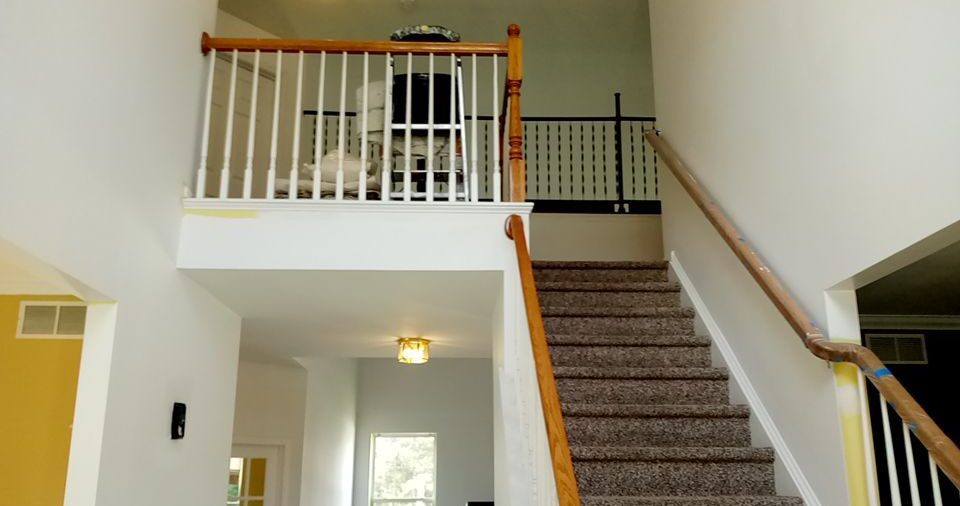The interior of your home is the side you see most often, and the wall colors play a significant role in the feelings you get when your spend time at home. So, you must take time when choosing your interior paint colors.
However, this process can be stressful. In this article, you’ll learn everything you need to know about interior painting, from understanding the psychology of colors to selecting a color scheme that suits your needs and preferences.
Let’s get to it.
Understanding the Psychology of Color
We perceive colors personally and emotionally, and just like colors make you feel happy, enthusiastic, calm, or sad, they can make a room feel spacious, crumped up, cozy, or relaxing. That’s why you can have a healthy sleep in one room and feel invigorated and active in another.
For these reasons, it’s important to choose interior colors that work best for you and your loved ones. Below are some of the common colors used in interior painting and the moods they represent:
Black
Black denotes power, mystery, and elegance, and it’s a favorite for ambitious and sophisticated personalities. However, you should be moderate with this color, as it can be depressing when overdone.
White
If you want to make your small room look bigger and airier, you can’t go wrong with white paint. It represents cleanliness, peace, purity, simplicity, and sophistication,
You also need to use white moderately, as too much can be overwhelming, sometimes straining your eyes. If you pair white with warm colors, it makes the other colors appear garish. It’s best to use pure white as an accent and off-white and creamy shades for large-scale decorations.
Red
This color tops the list of the most psychologically stimulating colors. Having this color in your home will always make you feel passionate, energetic, and courageous.
Since it also represents a high level of awareness and activity, red is excellent for use in exercising or gym area as it will keep you active and boost your performance.
Blue
This color of the sky inspires restfulness, making it an excellent option for your living room, bedroom, or bathroom. It blends perfectly with shades of green, white, and darker blues.
Yellow
This secondary color represents brightness and summer warmth. Besides evoking a cheerful mode and activating memory, yellow will help you think clearly and make sound decisions. This attribute makes it a perfect choice for your study room walls.
Green
This secondary color represents balance and harmony; unlike many interior colors, too much of it won’t feel overwhelming. It creates a feeling of stability and helps relieve stress. Painting your living room walls green will help you relax after a stressful day at work.
Purple
This rich color often represents royalty and quality. Purple also promotes introspection and in-depth contemplation, which inspires a higher awareness of thought and helps create a balance of mind, body, and spirit. However, too much purple can make your space feel gaudy and unbalanced.
Gray
This neutral color may represent independence, separation, or loneliness. It’s advisable to work with a professional painter to get the best out of the gray when it comes to interior painting.
Used in the right tone, this color can create a neutral, calming atmosphere in your room. However, too much of it or the wrong tone can make your room feel depressing and uninspiring.
Exploring Design Ideas
Before you embark on painting your interior, you need to figure out the look and feel you want to achieve. You can draw inspiration for interior painting from many places. Interior decor magazines and books have some of the best design ideas to transform your space with a fresh coat of paint.
You can also get ideas from your wardrobe; look at the colors that dominate your closet. Do you prefer lighter or darker tones?
You want to choose the right tones to create the right mood in your space. Keep in mind that lighter colors often work well as a background, whereas their darker counterparts are ideal for the ceiling and walls.
Choosing the Right Color Scheme
Selecting the right color scheme is another critical component of interior painting and an essential consideration when researching design ideas. You can choose from three primary types of color schemes depending on your specific needs and preferences:
Monochromatic
With this color scheme, you can use shades and tones of the same color to create a simple, stylish look.
Analogous
If you want to create an elegant and artistic look with a variety of colors, you can’t go wrong with an analogous home color scheme. This scheme involves selecting adjacent colors on the color wheel, with one dominant color and the rest enhancing the effect.
Complementary
With this color scheme, you need to choose tones opposite each other on the color wheel. A complementary color scheme intensifies each color’s temperature, adding drama to your space.
Trust GLS Painters for Quality Interior Painting in Mullica Hill
Besides understanding color psychology and choosing the right color scheme, careful preparation and correct brush strokes are critical to achieving a beautiful finish in interior painting. That’s why it’s best to work with an experienced, professional painter.
If you need reliable, professional interior painting in Mullica Hill, look no further than GLS Painters. We are experts in commercial painting, cabinet refinishing, and interior/exterior painting, and all our services come with a comprehensive workmanship warranty.
Contact us at 856-238-1288 for an estimate for a professional interior painting service today.
